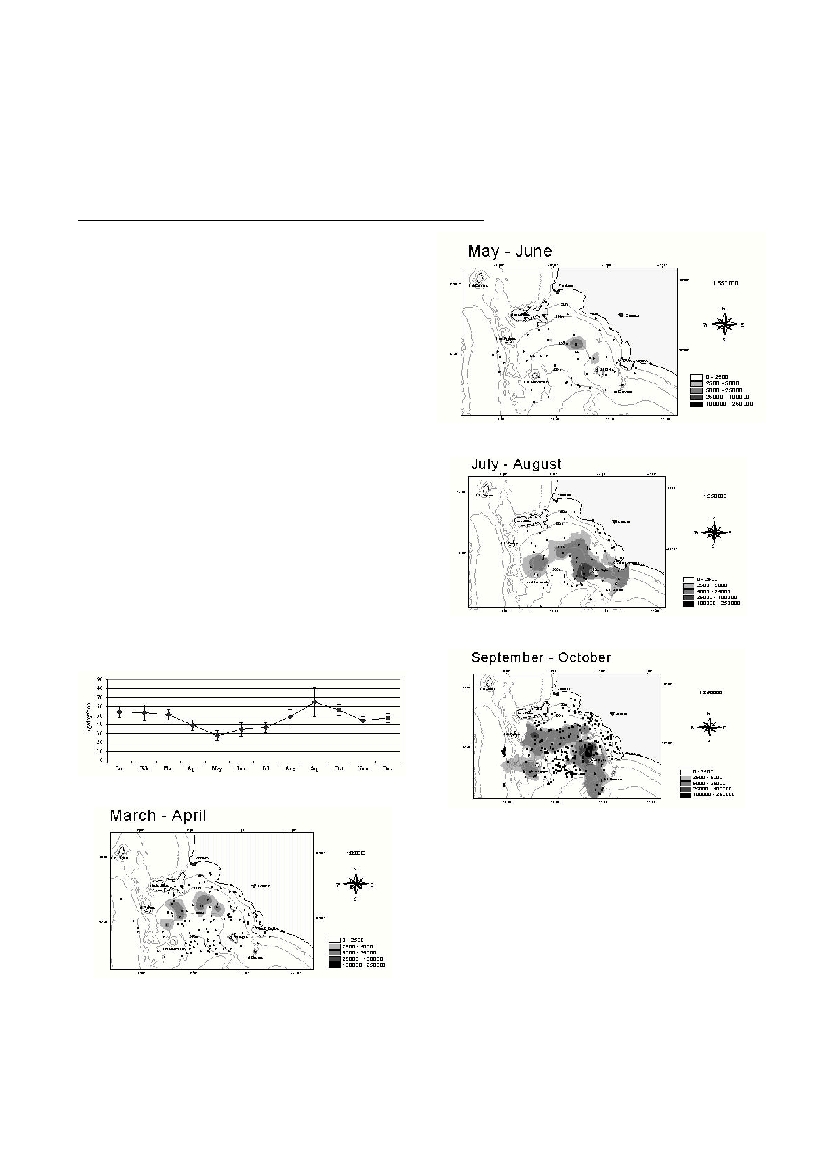Rapp. Comm. int. Mer Médit., 36,2001
238
Introduction
The European hake, Merluccius merluccius, is one of the most impor-
tant species exploited by the Mediterranean demersal fisheries. Trawl
catches are characterised by a high percentage of small specimens; thus,
for a better management of this species is important to improve the knowl-
edge of this phase of life. The purpose of the present study is to provide
additional data on the spatial distribution and seasonal concentration of the
specimens in the first year of life (0 group, individuals smaller than 12.5
cm of Total Length, TL), i.e. to localising the nursery area.
Material and methods
The inve
s
t
i
gated area was the northern Tyrrhenian Sea, where the juve
n
i
l
e
s
of European hake are exploited by the bottom trawlers. Data on size compo-
sition and abundance of juveniles were gathered by means of several traw
l
s
u
r
veys, funded by the Italian Government, carried out from 1985 to 1998,
during spring, summer and autumn, generally following a stratified random
design (1, 2). A
bundance data were standardised to number of specimens per
s
u
r
face unit (km
2
), using the swept area method. Data were converted in an
ARCHVIEW compatible format and interpolated by means of kriging (linear
function) in order to produce maps of bimonthly abundance of juveniles (3).
Further monthly data (from 1991 to 1998) on hake of Porto Santo Stefa
n
o
,
the most important landing place of this area, were collected.
Results
The size frequency distributions of the catches of the trawl surveys were
characterised, in all the considered periods, by a high percentage of small
specimens, particularly in September – October where the individuals
measuring less than 12.5 cm TL represented about 85% of the total abun-
dance. Juveniles were mostly distributed from 100 to 200 m depth and con-
centrated in areas around the Giglio Island and between Elba and
Montecristo Isles (Fig. 2,3,4,5).
The landing of hake is commercialised in three different categories,
according to the size of the specimens: the juveniles belong to the third cat-
egory (individuals smaller than 15 cm TL). The monthly landing per unit
effort of small specimens of M. merlucciusin Porto Santo Stefano (Fig.1)
confirmed the seasonal trend in the abundance of juveniles observed
through the experimental surveys: highest values were found in the period
late summer – early autumn, with a maximum in September.
Figure 1. Mean monthly landing per unit effort (kg/day/boat) of small
hakes (< 15 cm TL) in Porto Santo Stefano 1991-1998.
Figure 2. Spatial distribution of juveniles (specimens<12.5 cm TLper
km
2
) in the period March-April.
Figure 3.Spatial distribution of juveniles (specimens<12.5 cm TLper
km
2
) in the period May-June.
Figure 4. Spatial distribution of juveniles (specimens<12.5 cm TLper
km
2
) in the period July-August.
Figure 5. Spatial distribution of juveniles (specimens<12.5 cm TLper
km
2
) in the period September-October.
References
1 - Relini G. and Piccinetti C., 1994. Ten years of trawl surveys in Italian
seas (1985-95). Fao Fish. Rep., 533 (suppl): 21-41
2 - Relini G., 1998. Valutazione delle risorse demersali. Biol Mar. Medit.,
5 (3): 3-19
3 - Meaden, G.J. and Do Chi T., 1996. Geographical information system:
applications to marine fisheries. FAO Fisheries Technical Paper, 356,
FAO, Rome, 335p
SPATIAL DISTRIBUTION AND SEASONAL CONCENTRATION OF EUROPEAN HAKE’S JUVENILES,
MERLUCCIUS MERLUCCIUS(L. 1758), IN THE NORTH TYRRHENIAN SEA
Belcari P.
1
, De Ranieri S.
2
, Reale B.
2
, Sartor P.
1
, Sbrana M.
1
,Viva C.
2
1
Dipartimento Scienze dell’Uomo e dell’Ambiente, Università di Pisa, Italia - belcari@discat.unipi.it.
2
Centro Interuniversitario di Biologia Marina ed Ecologia Applicata, Livorno, Italia
Abstract
Data on abundance and size frequency distribution of European hake, Merluccius merluccius, collected in the northern Tyrrhenian Sea
during trawl surveys carried out from 1985 to 1998, were analysed using the Geographical Information System. The areas of concentration
of individuals smaller than 12.5 cm of Total Length were identified; charts of bimonthly distribution of the juveniles were produced.
Keywords : Fisheries, demersal, population dynamics, Tyrrhenian Sea, Teleostei.

